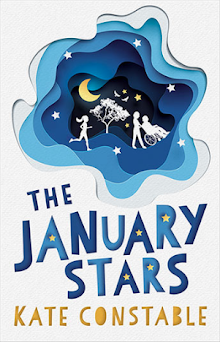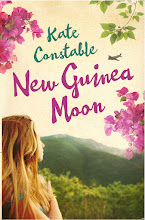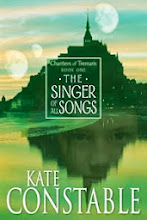I bought Alan Garner's Strandloper after finding it on the shelf at Brown & Bunting, my favourite secondhand book shop (they had two copies, so if you're interested, and you live near Northcote, you could pick one up yourself...) It is an adult novel, so don't look for it in the Children's/YA section.
Strandloper traces, in sparse, elliptical fashion, one version of the true story of William Buckley, a convict from Cheshire (Garner's own country), who was transported to Australia at the turn of the eighteenth century, escaped from the colony, and lived among the Aborigines of Port Phillip Bay for thirty years before reuniting with the white settlers. In Garner's novel, Buckley then returns to Cheshire, bringing his life full circle, and uniting Aboriginal and ancient Cheshire spirituality in his own person.
I have complicated feelings about this book. On one hand, it was a thrilling read, though it requires alert attention -- like Red Shift, the style is oblique and centred on dialogue. The period and local dialect is not translated for us and we must navigate by context and ear. Garner has taken liberties with Buckley's story - he remained illiterate until the end of his life, and he never returned to England after he was re-captured, spending his last years in Hobart; but the 'pattern' of Buckley's life as told here, from ancient fertility rites enacted in rural England, to the rich spiritual belief and practice of traditional Aborigines, and the final understanding that the patterns of ancient wisdom can overlap and speak to one another, is deeply satisfying and moving.
To me, the sections of the book dealing with the long period that Buckley (or Murrangurk, as he becomes) lives with the people of Port Phillip seem authentic and plausible. But what would I know? Murrangurk's tribe is designated the Beingalite, which seems to be a made-up name, which is problematic in itself, but as an account of lived, traditional tribal life, it feels as real and genuine as the sections dealing with Buckley's life before transportation. But again, how would I know? One reviewer accused Garner of resorting to faux-Biblical language to give these parts of the story a false weight -- I disagree with this judgement completely.
According to The Voice That Thunders, Garner consulted closely with an indigenous anthropologist while writing the book (annoyingly, he doesn't name her), and to me, he seems to have done an outstanding job of capturing the texture and flavour of Aboriginal life and belief. BUT at the end of the day, he is a whitefella from the other side of the world. When he describes sacred ceremony, sacred objects, sacred experience, is he speaking the truth, and if he is, should he be? Or is it an approximation of imagined, reconstructed belief? Or is he just imagining how things might have felt to Buckley, stitched together from William's own past (the Shick-Shack rite) and filtered through his own understanding, which is basically what Garner himself is doing in telling Buckley's story, and what we as readers of Strandloper are doing, too?
I guess I don't know what to make of the whole project, really. I love the idea that these ancient wisdoms are all related, and I love the idea of using William Buckley's story as a portal to explore that possibility, and the writing is (of course) superb. I didn't actually find this a difficult book, not as hard as Red Shift -- maybe having a little bit of background helped me, because there were certainly some bewildered readers and reviewers out there. But should Garner have even attempted to recreate traditional Aboriginal experience in the first place? Does he have the right to try? It took him twelve years to write this book. I'm in awe of the attempt and I'm very glad to have read it. I think it is extraordinary.
If anyone else out there has read Strandloper, I'd love to know what you think.
29.2.16
23.2.16
When Marnie Was There (Again)
It's only a year ago since I last read (re-read!) Joan G. Robinson's When Marnie Was There, so I'll spare you my thoughts, which are pretty much the same as last time. Suffice to say that this is one of my favourite childhood books, for many reasons.
But now I have also watched the Studio Ghibli film adaptation, so I might tell you about that. Book to film adaptations are always tricky, but this one did a pretty good job of preserving the dreamy, lonely atmosphere of the book, the beautiful setting of the marshes and the sea, and the friendship between two isolated children, who are linked in a way that isn't revealed until the end of the story. It was slightly weird, but not jarring, to see Anna transplanted to contemporary Japan, eating with chopsticks and riding fast trains.
The major difference to me was that Robinson's book is divided into two clear halves, the first dealing with Anna's friendship with Marnie, and the second to her friendship with the Lindsay family, who uncover the secret of Marnie's identity. In the film, these relationships overlap, and the big boisterous Lindsay family is pared down to just one brother and sister. I was a little sad about this, because the chapters with the Lindsays are some of my favourite parts of the book. But the section of the film where Anna's family history is explained is elegantly done, in a way that film can handle so subtly and neatly, where a book's explanations are a little clunky and awkward.
Overall, I think it's a success, if not a perfect one.
But now I have also watched the Studio Ghibli film adaptation, so I might tell you about that. Book to film adaptations are always tricky, but this one did a pretty good job of preserving the dreamy, lonely atmosphere of the book, the beautiful setting of the marshes and the sea, and the friendship between two isolated children, who are linked in a way that isn't revealed until the end of the story. It was slightly weird, but not jarring, to see Anna transplanted to contemporary Japan, eating with chopsticks and riding fast trains.
The major difference to me was that Robinson's book is divided into two clear halves, the first dealing with Anna's friendship with Marnie, and the second to her friendship with the Lindsay family, who uncover the secret of Marnie's identity. In the film, these relationships overlap, and the big boisterous Lindsay family is pared down to just one brother and sister. I was a little sad about this, because the chapters with the Lindsays are some of my favourite parts of the book. But the section of the film where Anna's family history is explained is elegantly done, in a way that film can handle so subtly and neatly, where a book's explanations are a little clunky and awkward.
Overall, I think it's a success, if not a perfect one.
20.2.16
The Voice That Thunders
I can't believe that I had never even heard of this extraordinary collection of essays and speeches by Alan Garner. It popped up when I was searching Brotherhood Books, and I ordered it from curiosity, but I am so glad that I did. Reading Garner's reflections, spanning twenty years, on writing, research, the land, history and archaeology, myth and language, mental illness and the creative process, was such a privilege. I read it slowly, to savour every word, and I have a feeling this will be a volume that I will return to over and over, for inspiration and wisdom.
Garner is not an easy writer, nor an easy man, one suspects, but his reverence for old stories, and for the corner of his country in Cheshire that his family has inhabited for generations, parallels the Australian Aboriginal experience -- it's no wonder he ended up writing Strandloper, the story of William Buckley, a Cheshire-born convict who escaped, then was rescued by and lived with the Wathaurong people for thirty two years. That book is the next on my to-read pile.
I found myself challenged by some of the things Garner says, but there is no doubt that he takes his responsibilities as a story-teller and a guardian of myth very seriously indeed. I was taken with a small school group to meet Alan Garner at The Little Bookroom in the early 80's; we were awed enough back then, but if I'd read this book first, I would have been completely speechless.
I've just done a clearout of books. I don't think I will ever discard this one. It might even join a very select collection indeed: books too precious to lend.
Garner is not an easy writer, nor an easy man, one suspects, but his reverence for old stories, and for the corner of his country in Cheshire that his family has inhabited for generations, parallels the Australian Aboriginal experience -- it's no wonder he ended up writing Strandloper, the story of William Buckley, a Cheshire-born convict who escaped, then was rescued by and lived with the Wathaurong people for thirty two years. That book is the next on my to-read pile.
I found myself challenged by some of the things Garner says, but there is no doubt that he takes his responsibilities as a story-teller and a guardian of myth very seriously indeed. I was taken with a small school group to meet Alan Garner at The Little Bookroom in the early 80's; we were awed enough back then, but if I'd read this book first, I would have been completely speechless.
I've just done a clearout of books. I don't think I will ever discard this one. It might even join a very select collection indeed: books too precious to lend.
17.2.16
Market Blues
I picked up Kirsty Murray's 2001 novel, Market Blues, a long time ago, but for some reason I hadn't got around to reading it until now (next month's theme for the Convent book club is Timey-Wimey).
Sam Sullivan is a twelve year old who's always in strife. His parents have split up and he's not happy about it, money is tight, and his sister has turned into a goth alien. The only thing that brings him joy is his trumpet, and it's playing the trumpet one day at the Victoria Market that catapults Sam back in time a hundred years into a very different world. Even if he manages to find his way home to his own time, how can he solve his problems?
Market Blues has all the virtues you'd expect from a Kirsty Murray story -- it's action packed, fast moving and carefully researched, painting a vivid portrait of Melbourne in 1900, complete with gangs of street arabs and newsboys, grinding poverty and a rich and varied street life, a city that's both familiar and strange. Sam's dilemmas are beautifully mirrored in the two streams of time, and an unexpected family tie draws him back with a sense of responsibility to try to put things right. Just like Back To The Future, Sam thinks he can use time travel to his advantage by placing bets on future events; but his grand plan is wrecked and he has to fall back on his wits and his natural ingenuity to cope instead. Sam is an engaging protagonist, flawed but resilient, and I had fun with him!
Sam Sullivan is a twelve year old who's always in strife. His parents have split up and he's not happy about it, money is tight, and his sister has turned into a goth alien. The only thing that brings him joy is his trumpet, and it's playing the trumpet one day at the Victoria Market that catapults Sam back in time a hundred years into a very different world. Even if he manages to find his way home to his own time, how can he solve his problems?
Market Blues has all the virtues you'd expect from a Kirsty Murray story -- it's action packed, fast moving and carefully researched, painting a vivid portrait of Melbourne in 1900, complete with gangs of street arabs and newsboys, grinding poverty and a rich and varied street life, a city that's both familiar and strange. Sam's dilemmas are beautifully mirrored in the two streams of time, and an unexpected family tie draws him back with a sense of responsibility to try to put things right. Just like Back To The Future, Sam thinks he can use time travel to his advantage by placing bets on future events; but his grand plan is wrecked and he has to fall back on his wits and his natural ingenuity to cope instead. Sam is an engaging protagonist, flawed but resilient, and I had fun with him!
12.2.16
King of the Middle March
The final volume of Kevin Crossley-Holland's Arthur trilogy, King of the Middle March, is a rather grim conclusion to the story of Arthur, a medieval squire turned crusader, who watches the life of the mythical King Arthur unfold in parallel with is own, in a magical stone (The Seeing Stone of the first volume).
I saw this on Brotherhood Books, and fresh from reading and revelling in Gatty's Tale, I snapped it up. I have read this before but I snuck in a second reading before lending it to my friend Suzanne, who loves these books as much as I do.
But the Arthur of this book, and his experience of crusade, is less joyful than Gatty's prilgrimage. He witnesses treachery and bloodshed, the cruel and muddled realities of war, and participates in violence himself. He doesn't even reach Jerusalem, his lord is wounded and Arthur must turn back to escort him home to England. There are plenty of truths here, about politics, religion and betrayal, that are just as relevant today as they would have been eight hundred years ago. And at the same time, in Arthur's magical stone, the story of King Arthur is reaching its own tragic conclusion.
But there are still moments of wonder and delight. Crossley-Holland's rich, poetic writing is as beautiful as ever; but I'm pleased this wasn't quite the last word in the story of Arthur's world. I'm glad that belongs to Gatty.
I saw this on Brotherhood Books, and fresh from reading and revelling in Gatty's Tale, I snapped it up. I have read this before but I snuck in a second reading before lending it to my friend Suzanne, who loves these books as much as I do.
But the Arthur of this book, and his experience of crusade, is less joyful than Gatty's prilgrimage. He witnesses treachery and bloodshed, the cruel and muddled realities of war, and participates in violence himself. He doesn't even reach Jerusalem, his lord is wounded and Arthur must turn back to escort him home to England. There are plenty of truths here, about politics, religion and betrayal, that are just as relevant today as they would have been eight hundred years ago. And at the same time, in Arthur's magical stone, the story of King Arthur is reaching its own tragic conclusion.
But there are still moments of wonder and delight. Crossley-Holland's rich, poetic writing is as beautiful as ever; but I'm pleased this wasn't quite the last word in the story of Arthur's world. I'm glad that belongs to Gatty.
Subscribe to:
Posts (Atom)


















